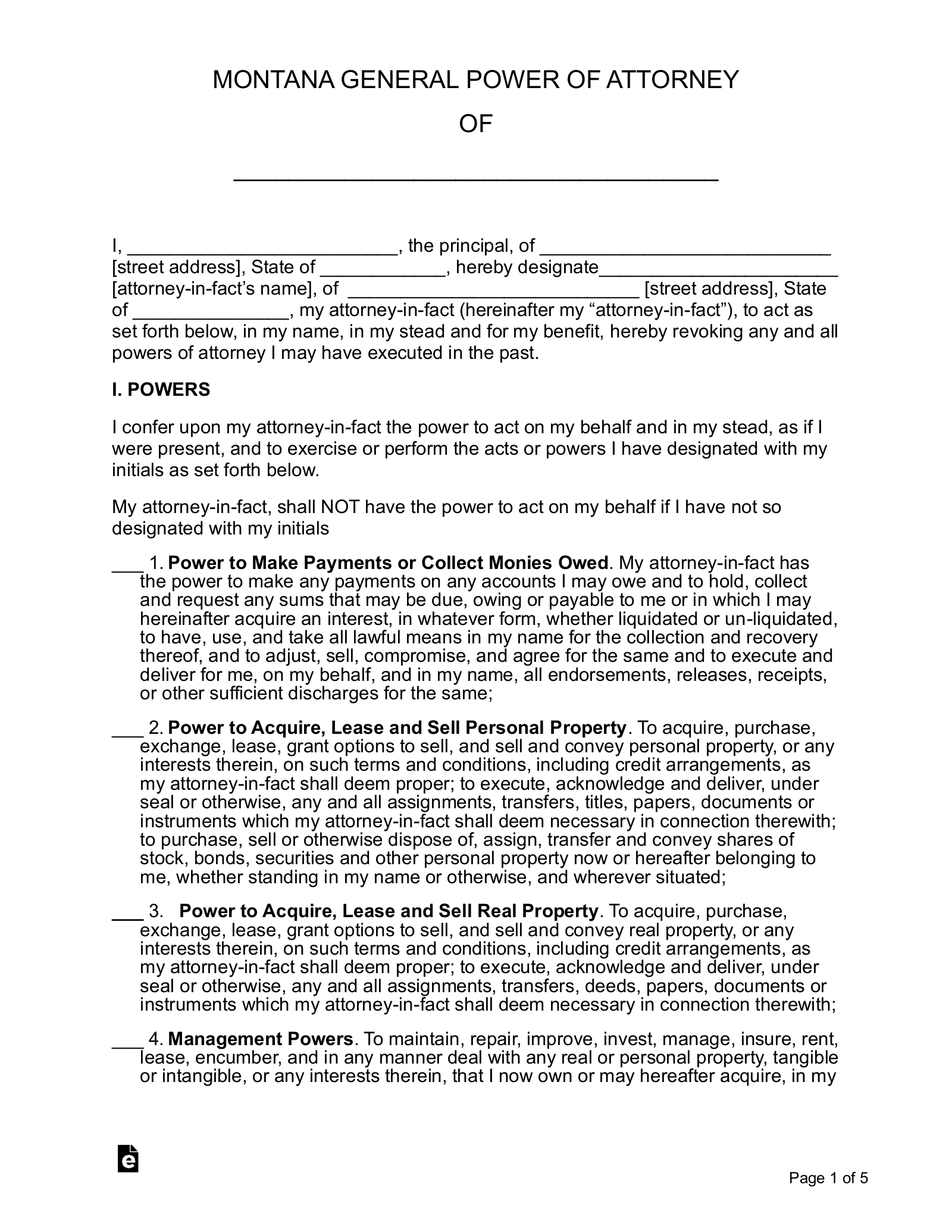Updated August 09, 2023
A Montana general (financial) power of attorney form is a document that allows a Montana resident to assign someone else the authority to act on their behalf. Usually, the person chosen for this task is someone who is close to the issuing Principal and proven to be a reliable individual. This form allows you to confer general powers over your property, which includes your money. This form is similar to the durable power of attorney except that there is one big difference. This type becomes void in the event you are incapacitated. If you are looking for planning during incapacity, you should use the durable form instead.
Laws
- Statutes – Uniform Power of Attorney Act
- Authority (MCA 72-31-336) – An agent under a power of attorney may act on behalf of the principal and exercise broad authority as granted by the agreement.
- Signing Requirements (MCA 72-31-305): The principal must have their signature acknowledged in the presence of a notary public.
How to Write
Download: PDF, MS Word, OpenDocument
1 – Identify The Principal At The Beginning Of This Document
You will need to record the Principal’s Full and Legal Name twice at the beginning of this document. First, enter it on the blank line in the Title.  Then, in the first paragraph, enter the Principal’s Full Name on the blank space preceding the words “The Principal…” at the beginning of this statement.
Then, in the first paragraph, enter the Principal’s Full Name on the blank space preceding the words “The Principal…” at the beginning of this statement.  Follow up the Principal’s Name with the Street Address of his or her Home Address (after the words “…The Principal Of”) and the State where he or she lives.
Follow up the Principal’s Name with the Street Address of his or her Home Address (after the words “…The Principal Of”) and the State where he or she lives. 
2 – Fill In the Attorney-in-Fact’s Information
The next few available spaces in the first paragraph will be concerned with identifying the Attorney-in-Fact. Find the words “…Hereby Designate,” then enter the Attorney-in-Fact’s Full and Legal Name. The next available blank line requires the Building Number, Street, and Apartment Number in the Attorney-in-Fact’s Residential Address.  Enter the State where the Attorney-in-Fact lives on the blank space in this paragraph.
Enter the State where the Attorney-in-Fact lives on the blank space in this paragraph.
3 – The Powers Defined In This Form Need The Principal’s Approval To Be Granted
The next section of this form, Article I, will be a comprehensive list of matters in the Principal’s life. Each paragraph will define Principal Actions and Principal Decisions the Attorney-in-Fact will be able to conduct by initialing the description he or she wishes to include in the Attorney-in-Fact’s definition of Principal Power. The Principal may initial some or all the Powers he or she wishes to grant to the Attorney-in-Fact at his or her discretion.
Item 1 will define how the Attorney-in-Fact will have the Principal “Power To Make Payments Or Collect Monies Owed” if it is initialed by the Principal.  The second item will define the Attorney-in-Fact’s Principal “Power To Acquire, Lease, And Sell Personal Property” on behalf of the Principal once it is initialed by the Principal.
The second item will define the Attorney-in-Fact’s Principal “Power To Acquire, Lease, And Sell Personal Property” on behalf of the Principal once it is initialed by the Principal.  Item 3 the Principal “Power to Acquire, Lease, and Sell Real Property” will empower the Attorney-in-Fact to deal with the Principal’s Real Property in the manner it defines once the Principal initials this item.
Item 3 the Principal “Power to Acquire, Lease, and Sell Real Property” will empower the Attorney-in-Fact to deal with the Principal’s Real Property in the manner it defines once the Principal initials this item.  If the Principal intends the Agent to have the same “Management Powers” he or she has, the Principal will need to initial the fourth item.
If the Principal intends the Agent to have the same “Management Powers” he or she has, the Principal will need to initial the fourth item.  The Principal will confer his or her “Banking Powers” to the Attorney-in-Fact, thus granting the Agent the Power to represent the Principal with financial institutions, when the Principal initials the fifth item.
The Principal will confer his or her “Banking Powers” to the Attorney-in-Fact, thus granting the Agent the Power to represent the Principal with financial institutions, when the Principal initials the fifth item.  The Principal will be able to grant Authority regarding Motor Vehicles by initialing the blank line just before the Number 6.
The Principal will be able to grant Authority regarding Motor Vehicles by initialing the blank line just before the Number 6.  If the Principal wishes to empower the Attorney-in-Fact with Principal Authority and “Tax Powers,” he or she should initial the seventh item.
If the Principal wishes to empower the Attorney-in-Fact with Principal Authority and “Tax Powers,” he or she should initial the seventh item. 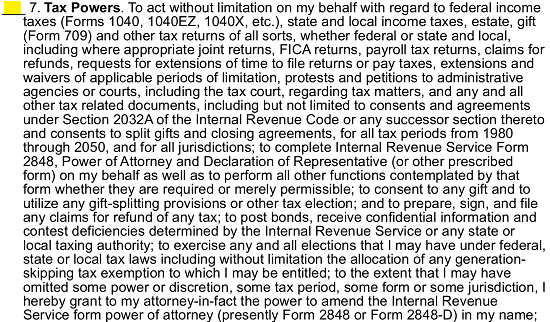 Item 8 will deliver the Principal Power to access and alter the Principal’s “Safe-Deposit Boxes,” if it is initialed by the Principal.
Item 8 will deliver the Principal Power to access and alter the Principal’s “Safe-Deposit Boxes,” if it is initialed by the Principal.  The Principal may assign “Gift Making Powers” to the Attorney-in-Fact by initialing the ninth item.
The Principal may assign “Gift Making Powers” to the Attorney-in-Fact by initialing the ninth item.  In Item 10, we will address the subject of “Lending And Borrowing.” It the Principal wishes to grant the Attorney-in-Fact with the Principal Authority it defines (i.e. Make Loans in the Principal’s Name), then he or she should initial the blank space provided.
In Item 10, we will address the subject of “Lending And Borrowing.” It the Principal wishes to grant the Attorney-in-Fact with the Principal Authority it defines (i.e. Make Loans in the Principal’s Name), then he or she should initial the blank space provided.  The Principal must initial the eleventh item if he or she wishes to empower the Attorney-in-Fact with the Power to affect his or her “Contracts” as if he or she were the Principal.
The Principal must initial the eleventh item if he or she wishes to empower the Attorney-in-Fact with the Power to affect his or her “Contracts” as if he or she were the Principal. ![]() The Principal may assign the Attorney-in-Fact with the Principal Power regarding the Principal’s “Health Care” by initialing the twelfth item.
The Principal may assign the Attorney-in-Fact with the Principal Power regarding the Principal’s “Health Care” by initialing the twelfth item.  If the Attorney-in-Fact should have the Principal Authority in terms of the Health Insurance Portability And Accountability Act of 1996, the Principal will need to initial Item 13 (labeled “HIPAA”).
If the Attorney-in-Fact should have the Principal Authority in terms of the Health Insurance Portability And Accountability Act of 1996, the Principal will need to initial Item 13 (labeled “HIPAA”). ![]() Item 14, the “Power To Hire And Pay For Services,” will describe all the Principal Actions and Decisions the Attorney-in-Fact can engage in on behalf of the Principal regarding hiring or firing such professionals as Accountants, Social Workers, Consultants, etc. in the Name of the Principal. The Principal will need to initial Item 14 to apply them to the Attorney-in-Fact’s Principal Powers.
Item 14, the “Power To Hire And Pay For Services,” will describe all the Principal Actions and Decisions the Attorney-in-Fact can engage in on behalf of the Principal regarding hiring or firing such professionals as Accountants, Social Workers, Consultants, etc. in the Name of the Principal. The Principal will need to initial Item 14 to apply them to the Attorney-in-Fact’s Principal Powers.  The fifteenth item shall discuss the “Reimbursement Of Attorney-in-Fact” and will list the actions the Attorney-in-Fact may take with Principal Power regarding this matter. The Principal may grant this Authority to the Attorney-in-Fact by initialing this paragraph.
The fifteenth item shall discuss the “Reimbursement Of Attorney-in-Fact” and will list the actions the Attorney-in-Fact may take with Principal Power regarding this matter. The Principal may grant this Authority to the Attorney-in-Fact by initialing this paragraph. ![]() Item 16 will enable the Principal to take action with the Principal “Power To Sue Third Parties Who Fail To Act Pursuant To Power Of Attorney, once the Principal initials the blank space provided.
Item 16 will enable the Principal to take action with the Principal “Power To Sue Third Parties Who Fail To Act Pursuant To Power Of Attorney, once the Principal initials the blank space provided.  If the Principal has determined that additional Powers should be granted to the Attorney-in-Fact, he or she should enter them on the blank lines in Item 17, then initial it. An attachment with a full report on such instructions may be included if there is not enough room (make sure any such attachment is properly labeled).
If the Principal has determined that additional Powers should be granted to the Attorney-in-Fact, he or she should enter them on the blank lines in Item 17, then initial it. An attachment with a full report on such instructions may be included if there is not enough room (make sure any such attachment is properly labeled).
4 – Clearly Define This Document’s Lifespan Of Effect
The Principal should have determined when the Attorney-in-Fact may use the Authority being granted. This Period of Effect must be recorded on this form before the Principal Signing. Naturally, we will begin this definition by reporting when the Attorney-in-Fact may begin utilizing Principal Authority. Locate the statement “To Indicate When This Document Shall Become Effective…” The Principal must initial one of the three choices below this statement to define when the Attorney-in-Fact will no longer be able to wield Principal Powers.
The Principal should initial the first choice and enter the desired Termination Date if he or she wishes the Authority given to the Attorney-in-Fact to automatically become effective upon this form’s execution. 
If the Principal wishes the Powers defined in this document to become effective starting on a specific Date, he or she should initial the second statement then, use the two blank lines to enter the first Calendar Date when the Attorney-in-Fact may access the Principal Powers described in the previous section.
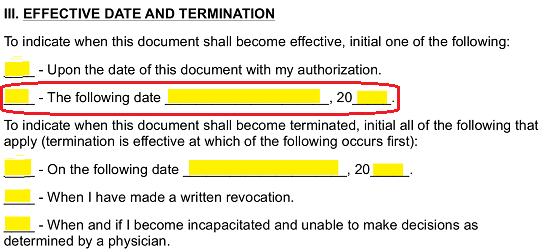
We should conclude this definition of Effective Term with a definition as to how these Powers will terminate. This definition can be provided through a Principal’s Signature next to the appropriate choice below the statement “To Indicate When This Document Shall Become Terminated…”
If the Principal prefers the Powers delivered through this form to automatically Terminate upon a specific Date, then he or she should initial the first statement. This choice will require the Principal’s preferred Date of Termination (DD/Month/YY) supplied across the blank spaces after the words “On The Following Date”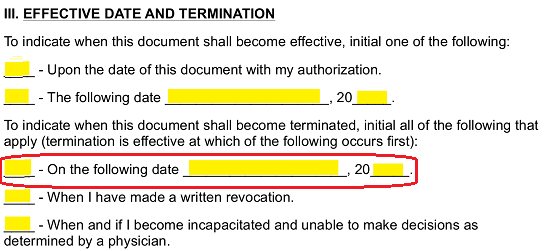 The Powers in this document may remain durable, terminated only by the Principal’s Revocation if the Principal initials the second choice.
The Powers in this document may remain durable, terminated only by the Principal’s Revocation if the Principal initials the second choice. 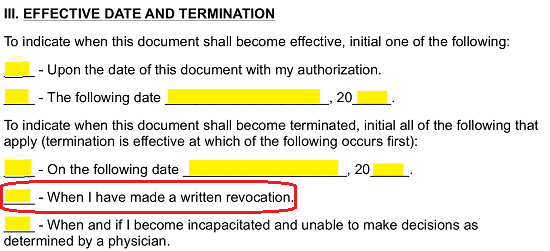 The Authority in this form will automatically terminate if the Principal is rendered unable to make his or her decisions (as per Physician Diagnosis) if the Principal initials this choice.
The Authority in this form will automatically terminate if the Principal is rendered unable to make his or her decisions (as per Physician Diagnosis) if the Principal initials this choice. 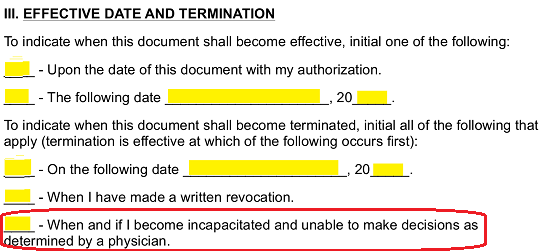
5 – Principal Execution Of This Form Occurs Only Upon The Principal Signature
The next section, “Article IV,” should be read by the Principal. Below this section, in the last statement, the Principal must enter the Calendar Day (Two Digits), the Month (written out), and the Year (Two Digits) he or she is signing this form.
The Principal must Sign his or her Name on the empty line below the words “Principal’s Signature” on the Date he or she recorded above. The Principal must also present his or her Name in Print on the empty line below the Signature Line.
6 – The Attorney-in-Fact Must Confirm This Appointment
Find the section labeled “Acceptance Of Appointment.” The Printed Name of the Attorney-in-Fact should be reported on the first blank line (in the paragraph). Once this is done, the Attorney-in-Fact should read the statement, then sign and print his or her Name on the blank lines labeled “Attorney-in-Fact’s Signature” and “Attorney-in-Fact’s Printed Name” (respectively).
7 – The Notary Public Has Been Provided With A Notarization Area
The Notary Public, observing this form’s execution, will verify several facts (location, date, attending parties), then supply his or her credentials and notarize this form.


